Discover 11 hidden attractions, cool sights, and unusual things to do in Quincy (United States). Don't miss out on these must-see attractions: Villa Kathrine, John Wood Mansion, and Bayview Bridge. Also, be sure to include Woodland Cemetery in your itinerary.
Below, you can find the list of the most amazing places you should visit in Quincy (Illinois).
Table of Contents
Villa Kathrine

Home in Quincy, Illinois. The Villa Kathrine is a Moroccan-style home located on the bluffs overlooking the Mississippi River in Quincy, Illinois. The unique home, sometimes branded as a castle, was built in 1900 by architect George Behrensmeyer for wealthy Quincy native W. George Metz. Metz had a fondness for Mediterranean architecture, and used the Villa Kathrine as his home when he was not venturing the world. Metz eventually sold the castle in 1912, and the site fell into disrepair and neglect before the non-profit Friends of the Castle sought to restore the Villa in 1978. Work on restoring the castle was completed in 1998, and appropriate site furnishings have been donated and obtained by staff throughout the years to further enhance the castle's Moroccan roots. Currently, the site functions as the official tourist information center to the City of Quincy and tours are granted of the site on an appointment basis.
Inside, the castle features a harem, a courtyard, and a reflecting pool. Much of the designs for the interior and exterior of the building were based upon W. George Metz's sketches of Islamic architecture that he observed during his global travels.
In 2010, the Villa Kathrine was used as a filming location in the Struber Productions film, Fang, which has yet to be released.[1]
Address: 532 Gardner Expy, 62301-4829 Quincy
John Wood Mansion

Building in Quincy, Illinois. The John Wood Mansion was built between 1835 and 1838 by John Wood, who in 1860 became the 12th governor of Illinois on the death of Governor William Bissell. The Wood family moved into the Greek Revival home situated at 12th and State Streets in Quincy, Illinois from an unusual two-story log cabin in 1837. Quincy is the county seat of Adams County. Wood founded both the county and city.
Wood's 14-room mansion was built by John Cleaveland and endured a move from its original site to its current location, about a block east, so Wood could build an even larger mansion. The Greek Revival building was added to the National Register of Historic Places on April 17, 1970, and in 2007 was named by the Association of Independent Architects one of Illinois' 150 most important architectural structures. The John Wood Mansion features four large Doric columns, which Wood himself turned at a lathe he built for that purpose, four large chimneys and many ornate details inside and out. A great many original Wood family and period furnishings are displayed throughout the mansion. Today it is owned and operated by the Historical Society of Quincy and Adams County.
The house is open for public tours from April through October. The Society also offers educational tours of the house to all local 3rd and 4th grade students each year, as well as special candlelight tours open to the public in December.
In celebration of the 2018 Illinois Bicentennial, the John Wood Mansion was selected as one of the Illinois 200 Great Places by the American Institute of Architects Illinois component (AIA Illinois).[2]
Address: 425 S 12th St, 62301-4303 Quincy
Bayview Bridge
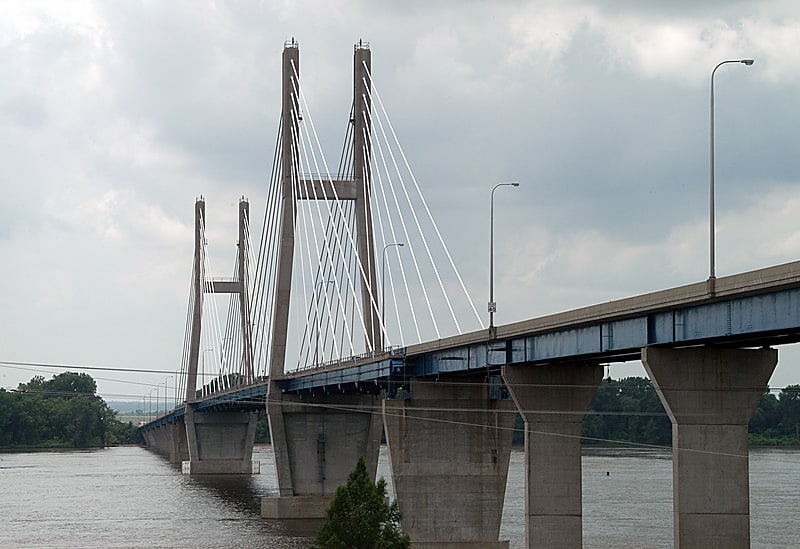
Cable-stayed bridge in Adams County, Illinois. The Bayview Bridge is a cable-stayed bridge bringing westbound U.S. Route 24 over the Mississippi River. It connects the cities of West Quincy, Missouri and Quincy, Illinois. Quincy Memorial Bridge serves Eastbound US-24. The bridge was built at a cost of $32 million, $3 million over budget.[3]
Woodland Cemetery
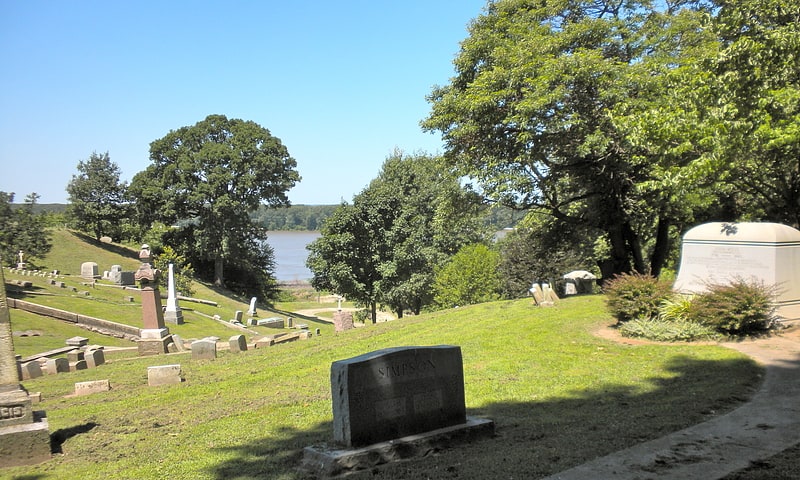
Cemetery in Quincy, Illinois. Woodland Cemetery is a historic cemetery located at 1020 South Fifth Street in Quincy, Illinois. Planned by politician John Wood and opened in 1846, the cemetery is a product of America's rural cemetery movement of the mid-nineteenth century. The cemetery's grave markers include smaller Victorian monuments and large Gothic Revival and Neoclassical structures. The cemetery was added to the National Register of Historic Places in 2002.[4]
Address: 1020 South 5th Street, Quincy
Quincy Museum
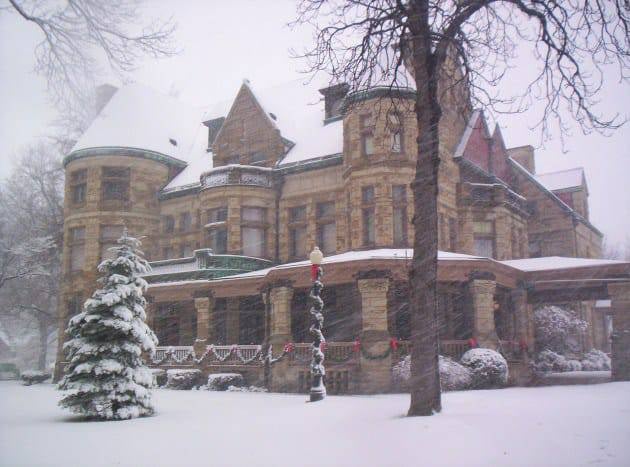
Museum, Specialty museum
Address: 1601 Maine St, 62301-4264 Quincy
Quincy Memorial Bridge

Truss bridge in Marion County, Missouri. The Quincy Memorial Bridge is a truss bridge over the Mississippi River in Quincy, Illinois. It brings eastbound U.S. Highway 24 into the city of Quincy from Missouri. It was built in 1930, initially as a toll bridge, and remains structurally sound.
Building of the bridge began in 1928 by the Kelly-Atkinson Company. It was completed in 1930, with the first car crossing the bridge on May 19th of that year on an official inspection trip. The original toll for the bridge was 50 cents, by 1945 the city had paid the outstanding bonds which financed the bridge's construction, and the fares were eliminated.
In 1986, to serve additional traffic volumes crossing the Mississippi River into Quincy, the Illinois Department of Transportation constructed the Bayview Bridge just to the north of the Memorial Bridge. Westbound traffic was then routed onto the Bayview Bridge, while eastbound traffic was routed onto the Memorial Bridge.
Since 2012, demolition and replacement of the historic Memorial Bridge with a more modern one is being considered by the Illinois Department of Transportation to cope with increased traffic demands on the aging bridge.[5]
Oakley-Lindsay Center

Convention center in Quincy, Illinois. The Oakley-Lindsay Center is the regional convention center for Quincy, Illinois and the tri-state region. It opened in 1995 at a cost of $8 million. It serves as the convention hub of the Quincy micropolitan area and fills the market in-between St. Louis and Iowa City.
The center served as a sandbagging focal point during the Flood of 2008 with over 1 million sandbags filled. The Oakley-Lindsay Center and the sandbagging effort was featured on many news organizations and even had a visit from then-presidential candidate Barack Obama (D-IL) on Saturday, June 14.[6]
Address: 300 Civic Center Plz, 62301 Quincy
Downtown Quincy Historic District

Historical place in Quincy, Illinois. The Downtown Quincy Historic District is a historic district located in downtown Quincy, Illinois, containing numerous buildings showcasing some of the city's late 19th century and early 20th century architecture. In the 1800s, Quincy was a popular destination for travelers making their way west via rail service. The Mississippi River was also a major economic benefit for the community, furthering the city's importance in commerce.[7]
Lock and Dam No. 21
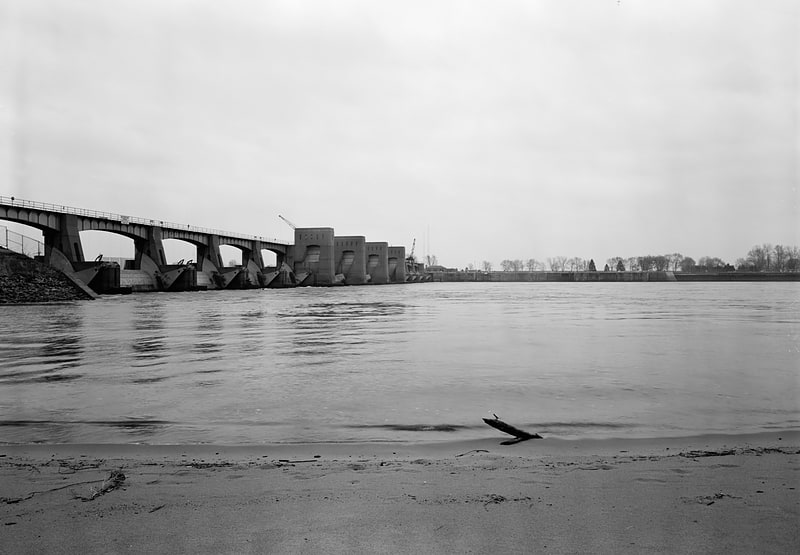
Lock and Dam No. 21 is a lock and dam located at Quincy, Illinois on the Upper Mississippi River around river mile 324.9. The movable portion of the dam is 1,265 feet long and consists of three roller gates and ten tainter gates. A 1,400 feet long submersible dike continues to the Missouri shore. The main lock is 110 feet wide by 600 feet long and there is also an incomplete auxiliary lock. In 2004, the facility was listed in the National Register of Historic Places as Lock and Dam No. 21 Historic District, #04000181 covering 1,075 acres, 1 building, 4 structures, 4 objects.
Currently there is a study being conducted by the city of Quincy to convert Lock & Dam No. 21, 20, and 22 into being hydroelectric by 2016.[8]
Richard F. Newcomb House
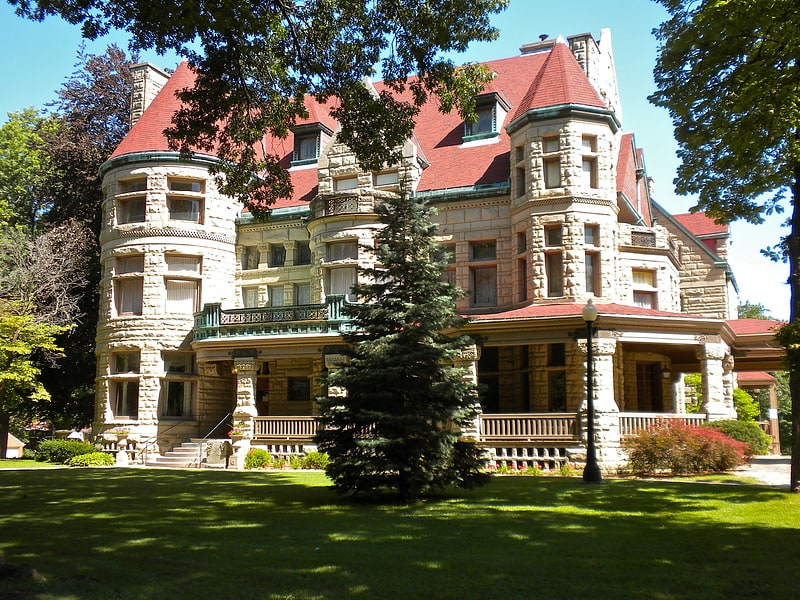
The Richard F. Newcomb House is a historic house located at 1601 Maine Street in Quincy, Illinois. The house was built in 1890-91 for Richard F. Newcomb, the founder of the Quincy Paper Company; the company eventually became a national strawboard-producing firm. Local architects Harvey Chatten and Ernest M. Wood collaborated on the house's Richardsonian Romanesque design; the style choice was inspired by the recently built William S. Warfield House, which Newcomb admired and wished to outdo. The three-story house has a massive limestone exterior with a red shingled roof. The house's wraparound front porch is supported by limestone pillars; smaller porches are located throughout the design. A large conical tower and a smaller octagonal tower rise from the southwest and southeast corners of the house respectively.
John A. Stillwell, Newcomb's son-in-law and president of the Electric Wheel Company, bought the house from Newcomb in 1910. The Stillwell family donated the house to Quincy College in 1941; the college used the house as a women's dormitory.
The house is now home to the Quincy Museum. The first floor has been restored, the second and third floors feature exhibits on local history, natural history, dinosaurs and area Native Americans.
The house was added to the National Register of Historic Places on June 3, 1982.[9]
Quincy National Cemetery
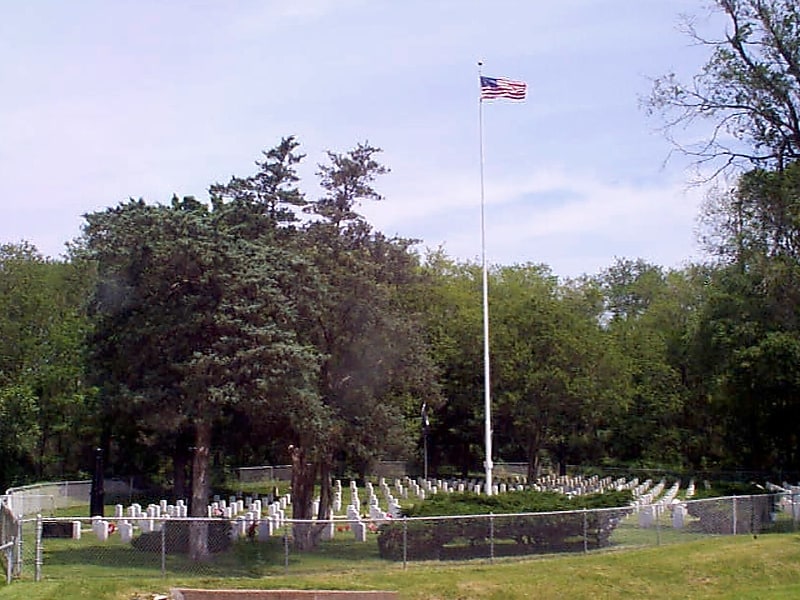
Cemetery. Quincy National Cemetery is a small United States National Cemetery located in the city of Quincy, in Adams County, Illinois. Administered by the United States Department of Veterans Affairs, it encompasses slightly less than a half an acre, and as 2014, had 690 interments. It is currently closed to new interments, and is maintained by Rock Island National Cemetery.[10]